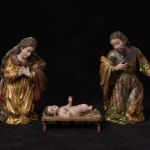NATIVITY
Virgin: 26.5 x 16 cm
Child: 15 x 7.5 cm
Provenance
Private Collection, Madrid.
In his 1978 catalogue, Estofados en la Nueva España, Xavier Moyssén presented an interesting document that has remained associated with the works with which it deals. This is the invoice Julián Fernández de Roldán, an intermediary living in New Guatemala, issued to the Marquis of Sierra Nevada" from Mexico City, on 7 October 1790, including the varying expenses involved in the "Nativity that has been delivered". The group of works referred to as with those being addressed here, is composed of a Virgin and St. Joseph, boch depicted kneeling and in contemplative adoration of the Divine Child who, lying in his crib, completes the group. This link, and the fact that we have records of the first group, make it a point of reference, as we now establish a preliminary comparative study to which we will be adding more images, many with the same iconography, supporting the Guatemalan attribution of the carvings we are dealing with here. In turn, we would insist on these works importance as benchmark pieces belonging to a sort of religious imagery being produced in said Central American country from the last third of the 18th until the first third of the 19th centuries, and an effective reflection of a system of artistic output driven by a fame and skill that set them apart at the time, making them highly sought-after items.



